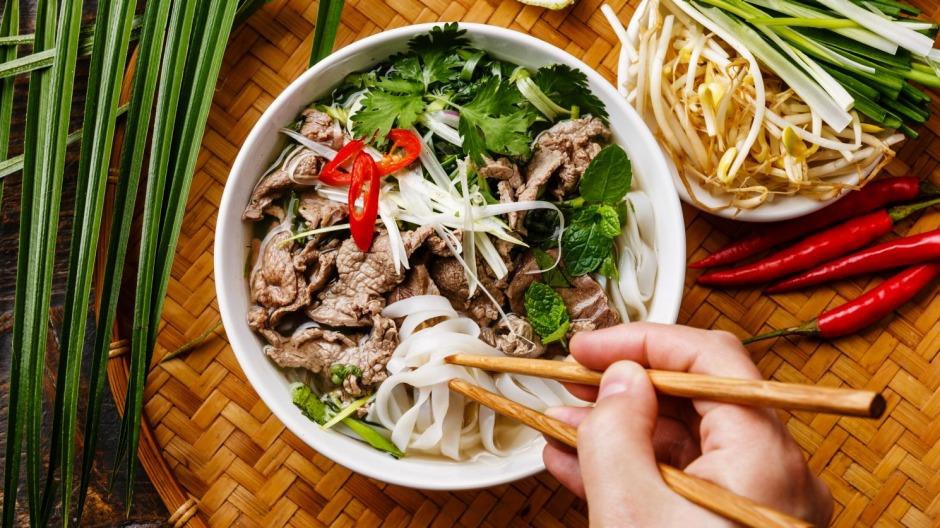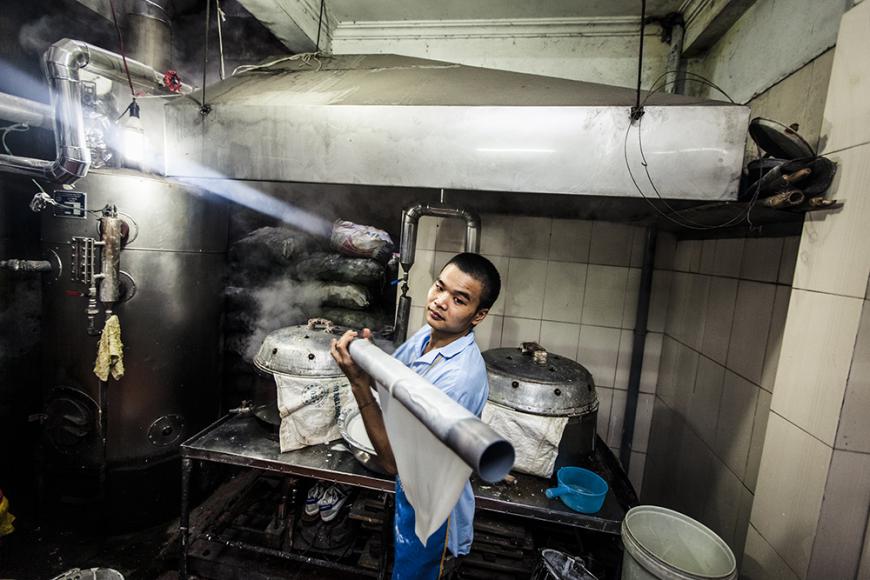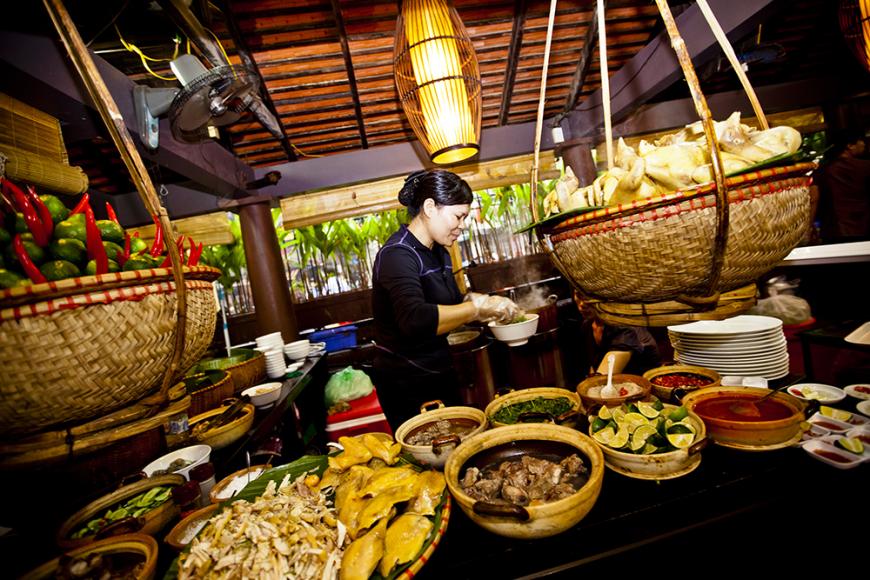Vietnamese Pho: A Taste of Heritage and Culture
Nam Dinh Province often goes unnoticed by casual visitors, despite its captivating charm. Nestled in the Red River Delta, this region is renowned for its sprawling agricultural landscapes and exquisite churches. It also proudly claims Tran Hung Dao, a national hero from the 13th century who played a pivotal role in repelling Mongol invasions. However, Nam Dinh's most enduring contribution to Vietnam lies in its delectable beef noodle soup, known as phở bò.
Vietnam's rich tapestry of legends and myths has woven an intricate backstory for many aspects of its history. Such is the case with phở, the nation's most renowned culinary masterpiece and an exceptional culinary export. In the bustling capital city of Hanoi, phở has become an indispensable breakfast staple.

( Vietnamsese Pho )
In the early morning hours, vibrant phở stalls emerge along the bustling sidewalks of Hanoi. Amidst swirling clouds of steam, skilled cooks meticulously craft each bowl to order. A fragrant broth, brought to a rolling boil, cascades over a bed of tender rice noodles and thinly sliced meat, harmonizing with an assortment of fresh herbs and chives. The culinary symphony continues as diners personalize their bowls, adding a tangy squeeze of lemon, fiery slices of red chili, aromatic basil leaves, and delightful dabs of hoisin sauce. A journey to Vietnam would be incomplete without savoring this quintessential experience.
Although Nam Dinh province holds the geographical origins of phở, its spiritual home undeniably resides in Hanoi. It is within the historical and cultural tapestry of Hanoi that phở garnered immense popularity.
The captivating history of phở unfolds in the late 19th century during the pinnacle of French colonialism. The demand for beef from the French community led to a significant increase in its availability throughout Vietnam. Consequently, an abundance of beef bones became accessible, which ingenious Chinese and Vietnamese vendors utilized to elevate and refine the flavors of Nam Dinh's broth.

(A man makes fresh rice noodles for pho at a small house near Bat Dan street in Hanoi)
Throughout the years, the popularity of phở flourished in the vibrant city of Hanoi. It underwent a remarkable transformation from its humble origins as xáo trâu, a modest soup comprising water buffalo meat slices simmered with rice vermicelli in broth. Gradually, this culinary gem evolved into a refined masterpiece known as Hanoi phở, characterized by delicate flavors and harmonious balance. The substitution of buffalo meat with succulent beef, the introduction of round rice noodles, and the meticulous refinement of the broth contributed to the perfection of this iconic dish.
The new incarnation of phở garnered immense appreciation from migrant workers hailing from the Chinese provinces of Yunnan and Guangdong. Its resemblance to the flavors of their homeland dishes resonated deeply with their palates. Simultaneously, the Vietnamese populace, who had developed a fondness for beef, embraced the newfound culinary delight wholeheartedly. By the 1930s, the bustling streets of the Old Quarter were adorned with gánh phở, mobile kitchens ingeniously balanced on bamboo poles, as roving vendors served their delectable phở to eager customers.
Ever since, phở has become deeply ingrained in the collective consciousness of the nation. It has transcended mere culinary delight and transformed into a cultural emblem. Poet Tu Mo eloquently captured the essence of phở in his renowned poem, "An Ode to Pho," praising its subtle flavors and celebrating its egalitarian nature—a dish cherished by both the affluent and the humble.
Similar to the ever-evolving landscape of Vietnam itself, phở has weathered significant transformations. In times of hardship, when scarcity prevailed, modest bowls of soup became a common sight on the streets. However, the most profound shift occurred when phở made its way to the southern regions, alongside the mass migration of millions of northerners following the partition of the country in 1954.
The journey of phở, spanning regions and generations, embodies the resilience and adaptability of Vietnamese culture. It serves as a tangible reminder of the shared heritage that unites the diverse people of this remarkable nation

A woman makes chicken pho at her stall at Quan An Ngon restaurant in Hanoi
In the bountiful southern region, where culinary creativity knows no bounds, phở chefs embraced a newfound freedom to experiment. They began infusing their broth with a touch of sweetness and adorning it with a vibrant medley of herbs, alongside tantalizing additions like hoisin and chili sauce. Thus, a perpetual "broth-off" was born, showcasing the ongoing rivalry between different versions of phở. While the Hanoi phở purists remain steadfast in their devotion to the simpler rendition, it is undeniable that both the northern and southern variations of this iconic dish are equally delectable.
Amidst the ongoing debate over the best phở in Vietnam, one can argue that the essence of this beloved dish has remained relatively unchanged since its early inception. While diverse cuts of meat have made their way onto the dining table, offering a range of options including rare beef (tái), flank (nạm), brisket (gầu), tripe (sách), tendon (gan), and meatballs (bò viên), the fundamental principles of phở have remained intact. A brief upheaval was witnessed with the introduction of chicken phở (phở gà) in 1939, causing a temporary stir. Nevertheless, phở, by and large, has remained loyal to its original foundations.
As the rich tapestry of Vietnam's culinary heritage continues to captivate taste buds around the world, the enduring allure of phở persists, symbolizing the essence of tradition, innovation, and cultural unity.

Pho is widely sold around Vietnam for one to two dollars a bowl
While phở has deep roots in tradition, it is by no means stagnant. A new generation of Vietnamese chefs is fearlessly exploring the boundaries of this beloved dish. They are introducing innovative elements like brown rice noodles and fresh pho noodle rolls, pushing the boundaries of what phở can be. In 2018, Anan Saigon made waves by unveiling a luxurious rendition of phở priced at $100, featuring opulent ingredients like truffle oil, wagyu beef, and foie gras. Furthermore, international chefs are taking phở to even greater heights of creativity, experimenting with unconventional additions such as crawfish and sous vide beef.
In modern times, the art of crafting the perfect phở broth involves a slow-cooking process that combines beef bones, flank steak, oxtails, charred onion, charred ginger, and an array of aromatic spices like star anise, cinnamon, cloves, black cardamom, and coriander. Chicken phở has also gained significant popularity as an alternative to the original beef version. In the northern regions, garnishes typically consist of fresh chili slices, lemon, and a few select herbs. On the other hand, southern phở exhibits a noticeable sweetness and offers a wide variety of options to choose from. In Central Vietnam, you may even encounter phở topped with poached eggs, adding a delightful twist to the culinary experience.
As one of the world's iconic noodle dishes, pho has rightfully earned its place of honor and respect. While it continues to evolve and inspire culinary innovation, its timeless essence remains cherished by food enthusiasts worldwide.